December 21, 2024 | 09:58 GMT +7
December 21, 2024 | 09:58 GMT +7
Hotline: 0913.378.918
December 21, 2024 | 09:58 GMT +7
Hotline: 0913.378.918
This was an opinion raised at the Workshop on "Sustainable Sand Management in the Mekong Delta and Solutions to Sand Scarcity from an Expert and Media Perspective", organized by the World Wide Fund for Nature in Vietnam (WWF-Vietnam) in collaboration with the Mekong Delta Representative Office under Vietnam Agriculture Newspaper. The event was held on the morning of December 19 in Can Tho City.
Mr. Ha Huy Anh, Country Manager of WWF-Vietnam\'s Sustainable Sand Management Project, stated that: many concerns were raised regarding an alarming shortage of sand for national key programs and traffic works in the Mekong Delta on the parliamentary forum and the media within the last few months. The amount of sand pouring into the Mekong Delta has been steadily decreasing over the years. The amount of sand pouring into the Delta is estimated at an average of 7 million cubic meters per year. However, the exploitation of sand can reach upwards of 27 to 30 million cubic meters every year, and 5 million cubic meters of sand is discharged into the sea every year. This annual average has dropped to only approximately 4.5 million cubic meter per year, with 10% of the sediment is sand.
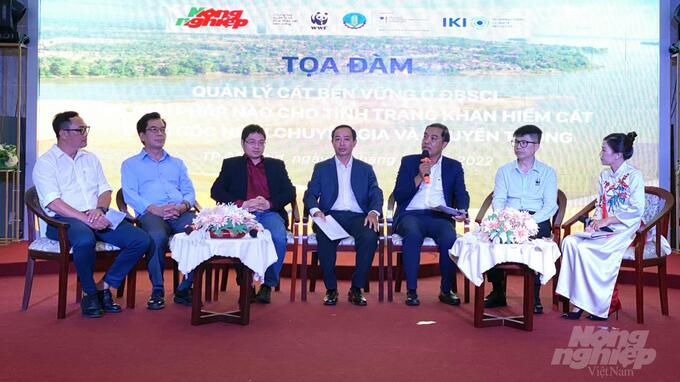
Workshop on "Sustainable Sand Management in the Mekong Delta and Solutions to Sand Scarcity from an Expert and Media Perspective", organized by the World Wide Fund for Nature in Vietnam (WWF-Vietnam) in collaboration with the Mekong Delta Representative Office under Vietnam Agriculture Newspaper. Photo: Hoang Vu.
The overexploitation of sand has reduced sand reserves in major rivers, increasing subsidence as a result. The lack of sand leads to riverbed and river bank erosion, loss of productive land, considerable damage to infrastructure works and civilian\'s property, etc. The lack of sand pouring into the sea leads to deeper coastal areas, resulting in greater impact from waves on the shore, and consequently, coastal erosion. The lowering of the river beds leads to lower water levels in the dry season, increasing saltwater intrusion into farming fields.
“Surveys have shown that there are deep holes caused by sand mining on the river bed in the Tien River near My Thuan Bridge; these holes can reach up to 50 meters in depth, threatening the safety of the works. Landslide occurences are increasingly common, severely damaging houses, roads, and productive land. Several households still hold ownership of the house, but their land has been lost due to landslides", warned Mr. Ha Huy Anh.
With the threat of increasingly severe sand scarcity, it is extremely important to find a substitute for sand, especially for use in construction. Studies have been conducted on alternative and recycled materials, artificial sand crushed from stone, ash, etc. Construction solutions include lowering sand usage, hollowing floors to reduce the amount of concrete as well as make the floor lighter. The Mekong Delta contains an abundance of rice husk ash, bagasse ash, kiln bottom ash, and fly ash with the potential to replace at least 30% of the sand used in making concrete without affecting the quality of the works.
Participants of the workshop suggested that sand mining should be based on sand bank (i.e, a localized source) instead of existing sand reserves in the riverbed. The functional sector must also establish a norm on the rate of alternative materials used in public works.

Sand mining in the Mekong Delta. Photo: Le Hoang Vu.
Dr. Nguyen Nghia Hung from the Southern Institute of Water Resources Research, said that the river is a living organism: the impact of hydroelectric dam in upstream areas will cause an increase in demand for sand in the downstream areas. Excessive sand mining reduces the depth of the river bed, causing a multitude of damaging consequences, including the increasingly frequent landslides.
Mr. Nguyen Huu Thien, an independent research expert on the Mekong Delta Ecosystem, confirmed that sand only returns to the Mekong Delta during great floods and the sand only flows 3 months a year. Hydroelectric dams act as walls, reducing the flow and preventing the river sand from returning to the Mekong Delta. The lack of sand will deepen the river bed, threatening the safety of large bridge constructions in the Tien and Hau rivers when deep holes appear near the foot of these bridges. Mr. Thien suggested that sand management must be linked on a regional scale, but not managed by provincial-level administrative units with ineffective sanctioning against sand mining.
According to Mr. Thien, it is necessary to recognize the role of sand, not only as a construction material, but also as a defense against landslindes. The ecological role of sand must also be emphasized: sand or sandy soil will be the natural habitat of many endemic plants and animals.
Sand cannot be pumped to level the ground during urban planning; instead it is necessary to create lakes and canals in urban areas as foundations for construction. Large lakes should be created in the Mekong Delta to store water for people's livelihood as well as establish a land fund.
Reporter Dinh Tuyen from Thanh Nien Newspaper said that illegal sand mining is a serious problem in the Mekong Delta because there is still a lack of transparency in terms of management, whereas the demand for sand is increasing. Authorities have solved cases of "ghost bills" illegally purchasing and selling millions of cubic meters of sand. As a result, there should be solutions to encourage the use of alternative materials in constructions and reduce the demand for sand. The government should prioritize the search for new solutions, the economical use of raw materials and the introduction of alternative materials into construction.

Journalist Nguyen Ngoc Thang, Head of the Mekong Delta Representative Office under Vietnam Agriculture Newspaper, suggested setting up a media club with the focus on sand, gathering complete data on sand banks, expert opinions, and models for using materials to replace sand among many other options. Photo: Hoang Vu.
Journalist Nguyen Ngoc Thang, Head of the Mekong Delta Representative Office under Vietnam Agriculture Newspaper, suggested setting up a media club with the focus on sand, gathering complete data on sand banks, expert opinions, and models for using materials to replace sand among many other options.
Dr. Duong Van Ni said that people of Mekong Delta see the river as a living organism; it needs food to survive through alluvium accretion; sand is its main energy source, if sand is lost, it will gradually lose dunes, islets, and alluvial plains along rivers due to landslides. Sand is considered to be the legs of the Mekong Delta; sand helps the land gradually encroach into the sea, to overexploit river sand and sea sand is to cut off these legs.
We are currently trading in only sand mining and transportation labor, not the value of sand grains themselves. Sand used for leveling is 10 times more than the amount of sand used for construction because it is sold under the expected value. On the other hand, concrete floors can be utilized in constructions to avoid spending a large amount of sand to enhance the foundation.
According to Mr. Hoang Viet, Sand Management Project Manager cum Freshwater Program Manager, WWF-Vietnam, Vietnam is facing many difficulties in terms of sand and we need alternative solutions. Sand banks are currently negative due to overexploitation. Therefore, the media needs to actively raise awareness so as to alert policymakers to more effective sand management solutions. Additionally, it is necessary to connect scientists, experts and stakeholders, to inform the public regarding the current shortage of sand.
Our goal is to construct green buildings while assessing the impact of climate change on the world. Over the past 15 years, our organization has researched multiple climate change adaptation programs and projects to ensure a green environment.
We find that in the most important aspect of the construction industry, with regards to building materials is sand, and the issue of sustainable sand mining is extremely pressing. Therefore, we need to cooperate with experts and researchers to establish programs and ensure the world's sand resources. We need to have solutions for sand mining control, tax policies, sanctions against coastal sand mining.
Moreover, we must reduce the amount of sand used for concrete beams and columns, and replace them with hollow lightweight concrete, or lightweight wall materials such as plaster.
Mr. Douglas Snyder - Managing Director, Vietnam Green Building Council (VGBC)
Translated by Nguyen Hai Long
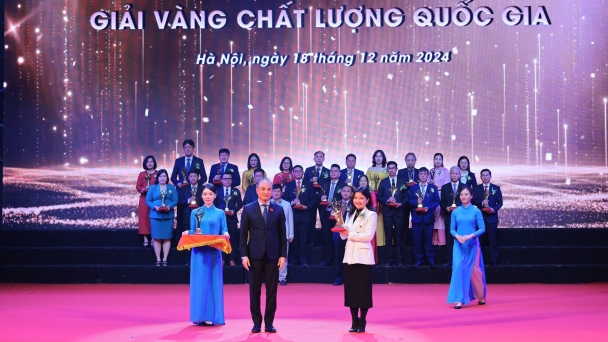
(VAN) On the evening of December 18th in Hanoi, the Ministry of Science and Technology held a ceremony to present the National Quality Awards for the years 2021, 2022 and 2023 to 133 businesses.
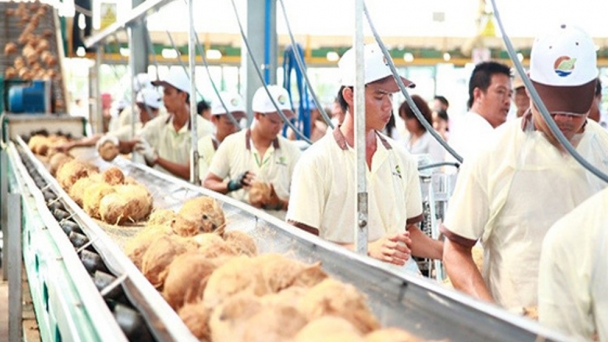
(VAN) On December 18, MARD and the People's Committee of Tien Giang Province hosted a forum in My Tho City to discuss the promotion of FDI and the increase in the export of coconut products.
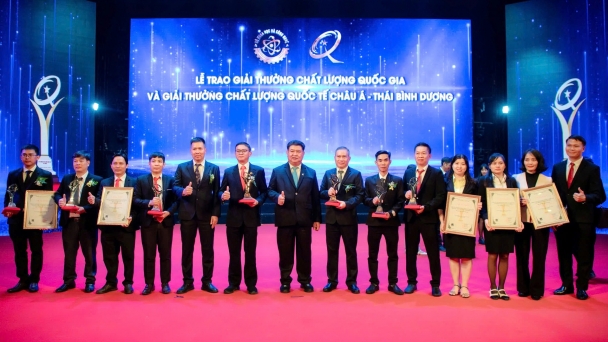
(VAN) The C.P. Vietnam Animal Feed Industry won multiple awards at the 'National Quality Awards Ceremony, Asia-Pacific Quality Awards 2021-2023'.
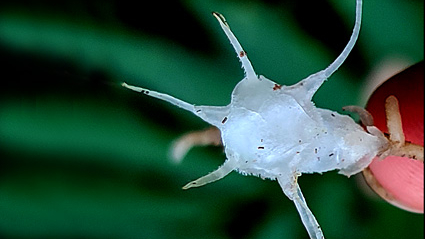
(VAN) A new non-photosynthetic plant founded in Xuan Lien Nature Reserve, adding further evidence that it is one of the most biologically diverse and ecologically significant protected areas in Vietnam.
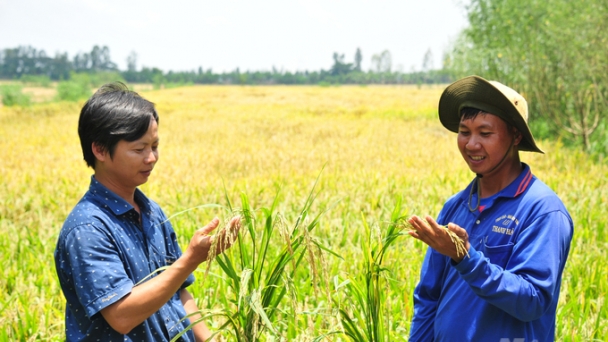
(VAN) Ecological rice farming not only reduces the impact of agricultural chemicals but also leverages the benefits of the flood season to restore the field ecosystem.
/2024/12/19/0314-0-nongnghiep-180309.jpg)
(VAN) With the motto of bringing vegetarian food to the world, Vuong Ngoc Vegan Company has turned cashew fruits, considered a waste product in agriculture, into premium vegetarian fish sauce.

(VAN) New technology enables hatcheries to quickly peer into millions of fertilized eggs and spot male embryos, then grind them up before they mature into chicks.